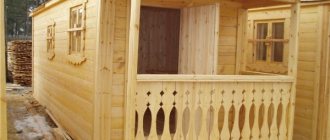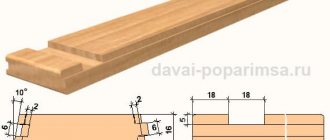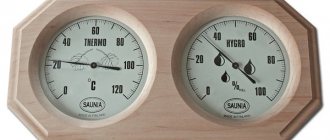Advantages of using a container as a basis for building a bathhouse
The bathhouse container has a number of advantages and attractive nuances that distinguish it from its direct competitors:
- Using a container as a basis for building a bathhouse guarantees a low budget for its construction. Very often, a container can be purchased inexpensively, and modern handling machines can easily load, deliver and unload the container at a construction site. Problems may arise with 40-foot products and to transport them you will need a semi-trailer and a crane with the appropriate characteristics;
- The container is endowed with an excessive margin of safety and has consistent and strict geometric planes, which allows even an amateur who is inexperienced in construction subtleties to build a bathhouse;
- The container design provides for the possibility of a block or modular arrangement of several units, both in the horizontal and vertical planes;
- The fitting-lock fastening system allows you to quickly and reliably fasten the structure on column-type foundations, which are more technologically advanced and easier to lay than strip foundations. The rigid design of the container block makes it possible to do without additional bracing of the lower perimeter of the container;
- If necessary, the container can be easily dismantled and transported to a new location.
What is the value of a container bath
Making a bathhouse from a container box is relatively easy. All you need to do is develop and plan:
- A system of powerful insulation of metal walls, otherwise in winter the sauna from a container will turn into a glacier covered with condensation, and in summer in the sun the temperature will easily reach 70 ° C;
- Ventilation diagram of the internal space and auxiliary insulation cavities;
- Water supply for shower and steam room;
- Installation of a stove or electrical heating connection for lamps and fan drives.
All this is not difficult to do, if not for one “but”. On the one hand, it is possible to sheathe or cover a metal box with bricks, SIP panels, aerated concrete slabs, and problems with room insulation and corrosion protection would be solved. But why then fence a garden with a heavy metal body? Offhand it turns out that it is cheaper to build a bathhouse without a container insert.
Most owners choose to build a bathhouse from a container, photo, if they require:
- Build a bathhouse with a strong frame for installation on heaving loams or sandy quicksand. Buying and building a full-fledged bathhouse from a 20 English foot container will cost less than the hassle of rearranging timber or log crowns;
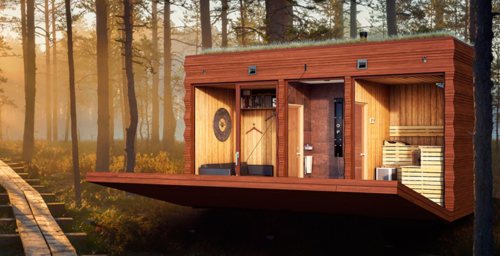
- Make a small-sized steam room on wheels, which can be taken for a season to a vacation spot, to a country house, or to a full-scale construction site. A bathhouse made from a 5-ton container can easily fit in the back of a Bull or a Ford truck.
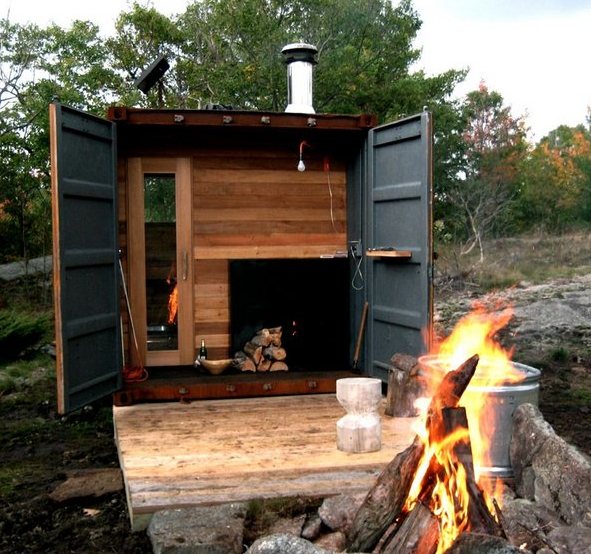
Important! A container bathhouse does not require a full foundation, regardless of whether it is a bathhouse made from a 20-foot container, or whether it is planned to use several 5-ton boxes. A flat area filled with sand and gravel is sufficient.
Several container boxes, one of which is allocated for a dacha, after finishing and connecting communications, can easily serve as a full-fledged country house.
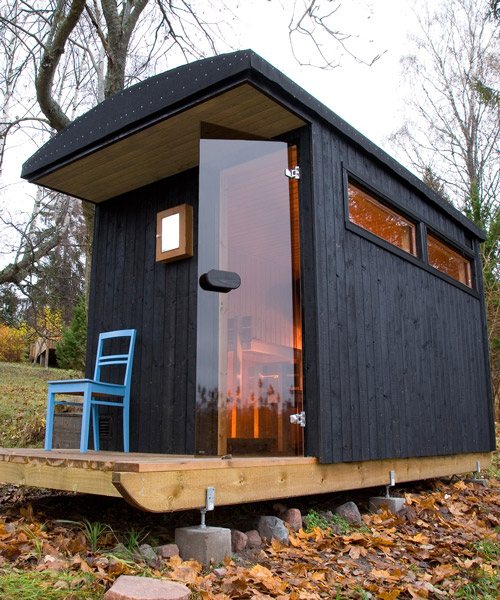
If the five-ton truck is used as an extension to an ordinary country house, the task can be simplified. For example, make only a steam room out of a container, and use the premises of a country house for relaxation and washing.
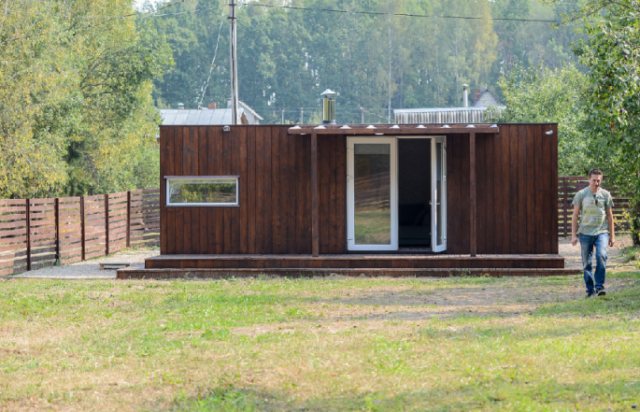
After trimming the side walls, the container body can become a frame for arranging an ordinary stationary bathhouse, built in accordance with all the rules and laws of heating engineering.
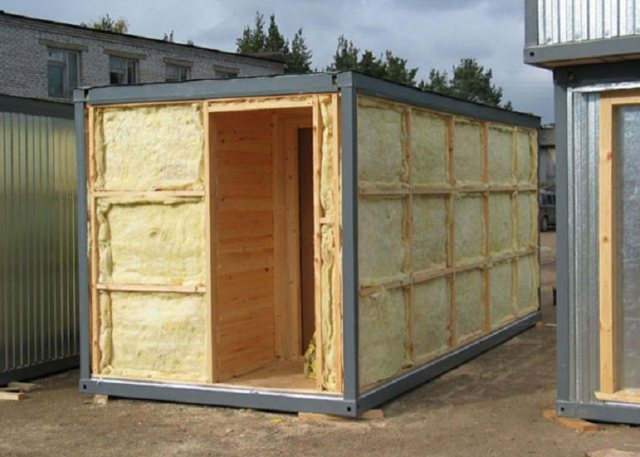
To do this, you don’t need to purchase a new or a whole container; you can buy a box with holes in the walls literally for the price of scrap metal, and it will be cheaper than:
- Pour the foundation;
- Spend half a cube of high-quality timber on the arrangement of racks and the upper and lower frame of the frame of the future bathhouse.
It will only be necessary to insulate the bathhouse on a container frame and veneer it both on the inside and on the outside of the building.
Pros and cons of container baths
Before you begin to analyze the strengths and weaknesses of the solution, you need to understand what aspects of building a bathhouse from a sea container will have to be developed independently:
- metal walls need powerful insulation, otherwise in the winter months the layer of condensation on the walls will turn into ice, and in the summer the room will overheat under the influence of the sun;
- the cavities of the insulation and the internal space must be well ventilated;
- water should be supplied to the steam room and washing room;
- it is necessary to supply electricity for lighting and, if necessary, for forced ventilation.
In Moscow and the regions, the construction of such a structure is justified in the following cases:
- if a structure with a strong frame is needed, since construction is planned on sandy quicksand or heaving loams. In such conditions, purchasing and re-equipping a 20-foot container is more rational in terms of investment than relaying crowns from logs or timber;
- when there is a need for a compact bathhouse on wheels, which can be conveniently transported to a summer house, construction site, or vacation spot. A small-sized steam room made from a 5-ton container will fit in the back of a Ford or Bull truck;
- if it is not possible to arrange a full-fledged foundation. In most cases, a leveled area with a bed of sand and gravel is sufficient.
Speaking of block containers
This is what the container looks like
Wooden cabins, also called modular containers, are often purchased and installed as housing for security guards or construction workers - they can be seen at construction sites, at posts, and so on.
It is from these that you can make baths - using either one or two blocks. Such a bathhouse will be an excellent solution for a summer cottage, and will have a number of advantages.
She will be:
- Mobile - if necessary, it can be transported from one site to another with minimal effort.
- Inexpensive - to carry out such work, used containers are purchased, which are not at all expensive, and the main costs for such construction come precisely from the purchase of this product.
- Easy to create - in order to make a bathhouse, you will need to follow the simplest instructions.
- Constructed with a minimum workforce.
Thus, a bathhouse made from a container block will be an excellent alternative to a permanent log bathhouse or another version of this building.
Advantages
And the block container will show itself at its best within the framework of this design.
Its advantages are realized, such as:
- Readiness for immediate use, laid down at the factory during the manufacture of such a product;
- Possibility of quick installation;
- Fast delivery to the construction site;
- Relatively cheap.
If you use two containers when creating a bathhouse, this will guarantee you even more interesting possibilities, and your bathhouse in a container can also become two-story, for example. For a two-story bathhouse you will have to make a metal frame, and if there are no problems with this, the structure will be created very quickly.
Technology for making a two-story bathhouse from containers
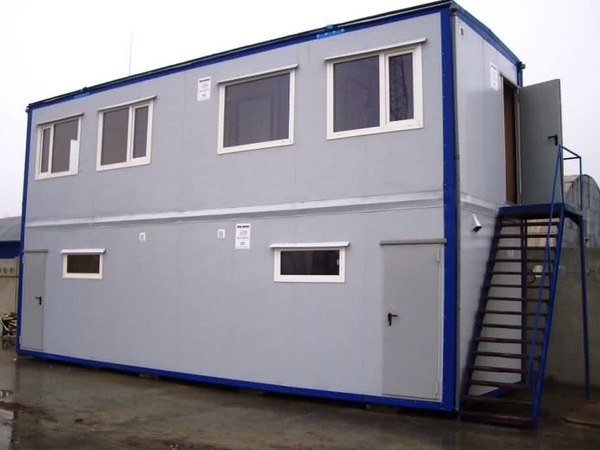
Double-decker container structures are very typical
So, how to make a bathhouse out of a container?
In fact, everything is not so complicated.
- First you need to create a base from curved corners (90 mm) and a steel welded structure - channels (120 mm).
- This base should be sheathed with timber on the outside. A block house can also be used for this purpose.
- The inside of the container must be lined with decorative timber or eurolining.
- Between the side walls, their outer and inner parts, insulation for the bath should be laid.
If the structure does not require the creation of a frame, if your container does not have any defects, then you only need to work on its additional insulation - this will significantly simplify the work, speed it up, and eliminate the need to purchase additional materials.
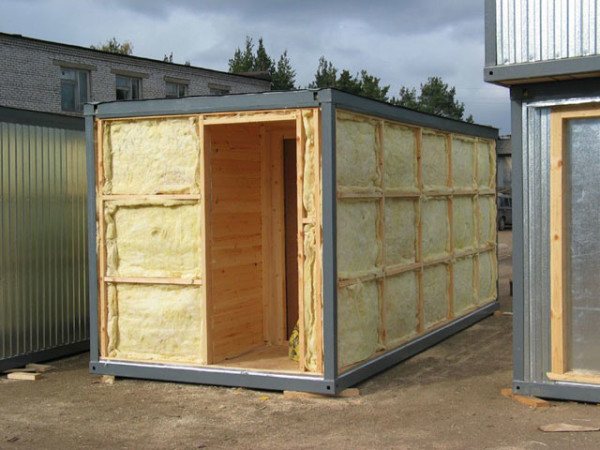
Insulation is in progress.
Important! For this purpose, you should purchase glassine - a special insulation for baths. You cannot use materials that are not suitable specifically for baths - this can backfire. You should also use mineral wool insulation, for example, Knauf. It is important that it is free of impurities, made from pure mineral wool.
These materials will not produce harmful fumes even when exposed to high temperatures, will not lose their properties due to heat or humidity, and will provide the necessary microclimate in the bathhouse. That's why they are recommended.
After this, it is necessary to lay the floor, which is recommended to be made from tongue-and-groove boards with a thickness of about 27 mm. In fact, after carrying out such work, the container-type bathhouse is ready, and all that remains is to install the necessary communications and install the boiler.
You will probably decide to make windows too - to create them it is better to use three-dimensional double-glazed windows that do not allow heat to pass through.
Rebuild without errors
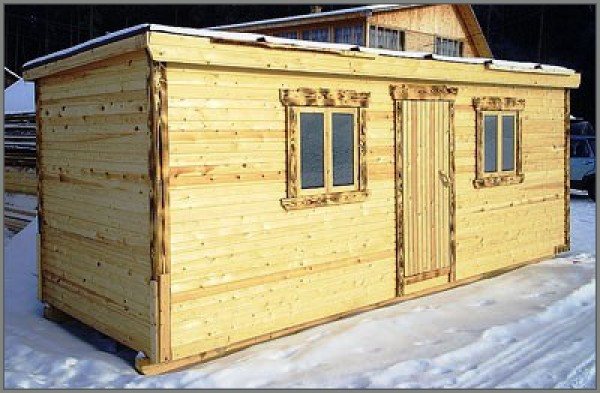
Practical and neat
If you are building a bathhouse from a 20-foot container or from a container of another type, it is important to remember not only these simple recommendations and follow this algorithm, but also remember a number of important aspects that will ensure your bathhouse durability and the absence of design flaws. Watch the video in this article, and read some information about the basics of proper installation of a bathhouse below.
For such work, it is worth purchasing a container in good condition - this will eliminate the need to work on the frame; it will already be quite reliable. Or you can buy a new container, if the funds allow you to make such a purchase.
When performing facing work with your own hands, it is important to remember three points.
- Thermal insulation must be sufficient to retain heat in the room.
- Waterproofing also requires special attention; it is advisable to do it both internally and externally.
- All communications must be installed taking into account safety standards and requirements.
Also, any instructions for creating such a structure will assume the need to withstand serious temperature changes. This means that the ventilation of such a bathhouse room must be done with your own hands at a decent level, especially under the floor.
Otherwise, the structure will be subject to rapid destruction and will quickly begin to rot at the root and fall apart.
It is for this reason that it is recommended to install baths of this type on supports that will raise it by 250-300 mm, this will be quite enough. Both cinder blocks and any other available materials can be used as such elevated supports. If you take a cinder block, use it in increments of a meter or half a meter.
Important! You can raise the cabin using special equipment, or with a lever or jack. It is better to do this before the start of facing work.
A change house converted into a bathhouse does not necessarily have to be a single room. Quite the opposite - it is usually interrupted with one or two partitions to build a dressing room and washbasin, for example.
This is exactly how you should act, placing the boiler against the far partition made of clapboard, so that it effectively warms up the two closest rooms, except for the dressing room. And the photo will show how best to do it.
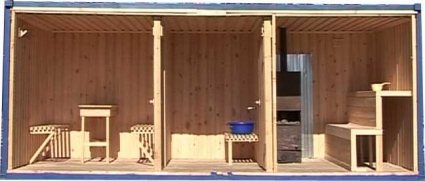
Three sections inside one container.
Required tools and materials

Several designs of twenty-foot containers are suitable for making your own bath structure. The standard version of the Dry Cube model has a height of 259.1 cm and a width of 243.8 cm. There is also a more voluminous container model - High Cube. It has a height of 289.6 cm and a width of 605.8 cm.
For interior work you will need:
- parts of the electrical network with protective boxes and cable ducts;
- elements of pipelines for water supply and sanitation;
- thermal insulation;
- steam and waterproofing;
- anti-corrosion compounds and protective liquids;
- lining and timber for interior decoration;
- sunbed elements.
The external decoration of the bath can be made of almost any material.
Container structures are portable and can be easily transported for installation in another location. They are hygroscopic and are also not susceptible to damage by insect pests and fungal colonies. However, a metal product may experience corrosive changes, which must be taken into account when choosing a method for processing the structure.
Metal block container price
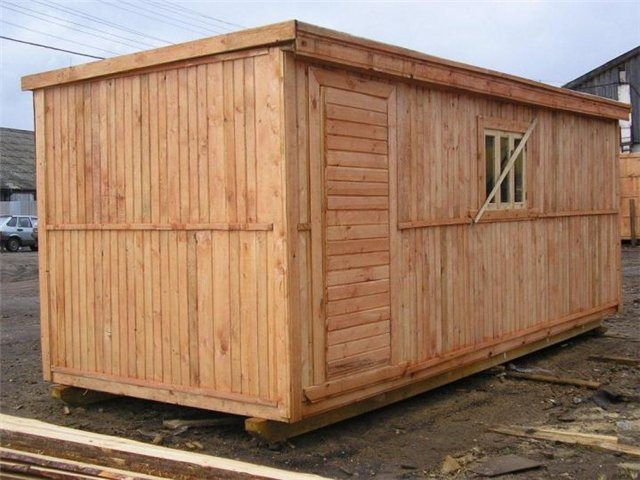
The best price and quality, of course, is from the manufacturer. In addition, it is important to know that the manufacturer does not have any additional markups or commissions, unlike those companies that are engaged in resale and do not produce block containers themselves.
Choosing a location for a container bath
According to generally accepted norms and rules, a bathhouse made from a sea container should be located:
- From the junction with the neighboring site at a distance of at least 5 m.
- From a residential building within its own plot, at least 4 m.
- From the maximum water line, within the coastline, at least 20 m.
Important! Particular attention should be paid when choosing a location, taking into account the upcoming installation. The container is a bulky and dimensional structure, made as one whole, therefore, in the area of operation of the lifting mechanism there should not be buildings and structures, their individual elements, electrical wires, pipes of air systems, gas, water and heat communications.
The site itself must have a leveled topography and there must be no wetlands that could make delivery and installation of the structure by road impossible.
Where to place it?
If we talk about generally accepted norms and rules, then the bathhouse from the container must be positioned as follows:
- the distance to the neighboring area must be at least 5 meters:
- the distance between the bathhouse and residential buildings should be within 4 meters;
- The container should be located at a distance of 20 meters from the coastline.
In addition, the place where the bathhouse will be located must be level and not swampy.
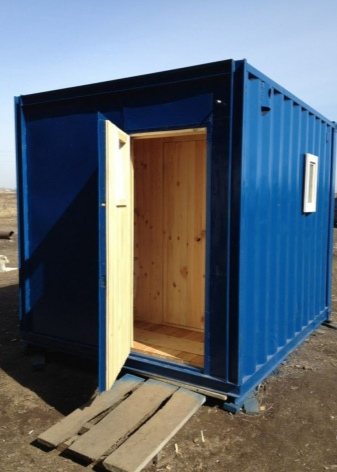
Site preparation and planning
To begin with, the construction site is cleared of vegetation and debris. The soil is carefully compacted and leveled.
The marking of the territory is carried out taking into account the functional areas of the bathhouse and the drainage system. It would be optimal to arrange a locker room closer to the entrance, followed by a shower room, and then a steam room. This way heat loss is minimized: the boiler is mounted to the internal partition of the steam room to heat the adjacent room. Also, this layout minimizes the consumption of pipes for hot water supply.
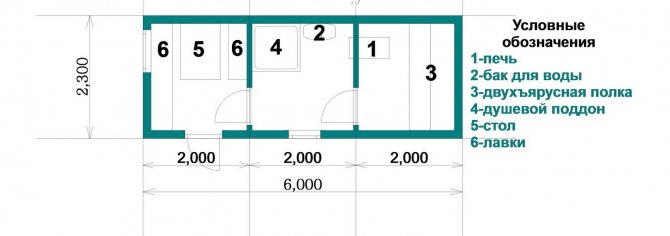
The photo shows a project for a bathhouse made from a 20-foot-long sea container.
If you want a larger steam room, purchase a container with a longer length, such as 40 feet.
Design and zoning options
Below is a diagram of a typical solution:
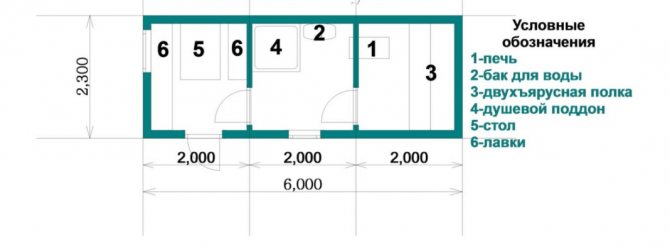
Scheme of a bathhouse from a container
This bathhouse project from a 20-foot container is formed by three rooms, the total usable area is 10-12 square meters. m. The first right block is a steam room with an installed electric stove, the second is a washing room with a shower, and the third is both a locker room and a resting place.
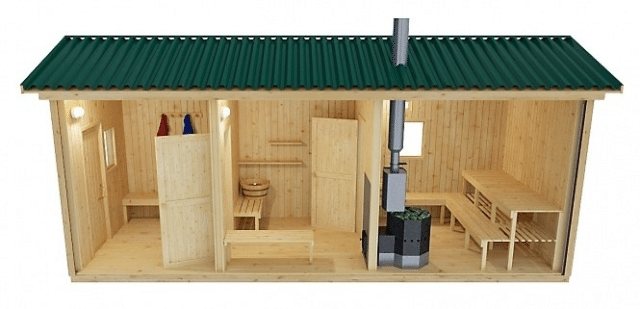
What does a container bath look like?
The entire interior in this example is finished with clapboard; a block house or siding can be used to cover the facade.
Finishing a bathhouse from a container: basic recommendations
When performing finishing work in a bathhouse from a container, it should be taken into account that:
- For interior decoration, lining is perfect. It can be made of aspen or pine, as well as exotic tree species;
- If you use pine boards in a steam room, you should first heat the stove and carefully remove any resin that appears without waiting for it to dry.
After the main work on installing and arranging a bathhouse from a sea container is completed, you can proceed to treating wooden surfaces with special compounds. This measure will not only significantly improve the appearance of the wood, but will also serve as an excellent preventive measure against mold, mildew and premature wear.
If this step is skipped, the untreated wood loses its color and gradually, over about 3 to 5 years, begins to darken. And this worsens the aesthetic appearance of the bathhouse.
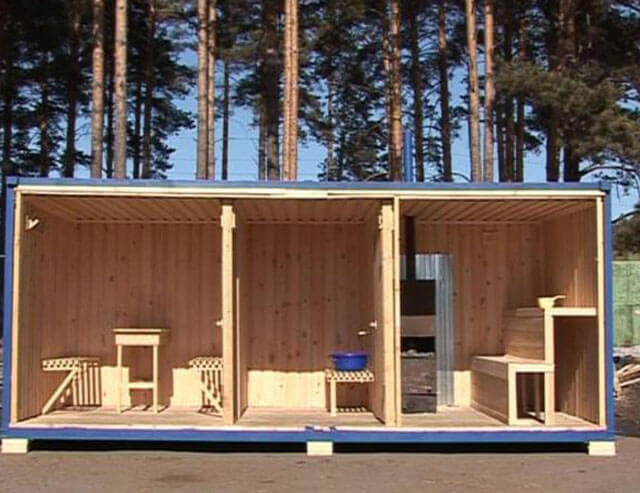
It is mandatory to treat wooden surfaces in the locker room and shower areas. To do this, you can choose universal formulations based on natural oils or wax. Their operating principle is approximately the same: penetrating into the deep layers of wood, they form a protective film on its surface.
However, it is important to remember that such compositions are not suitable for treating sun loungers in a steam room, as they can cause burns if they come into contact with the skin!
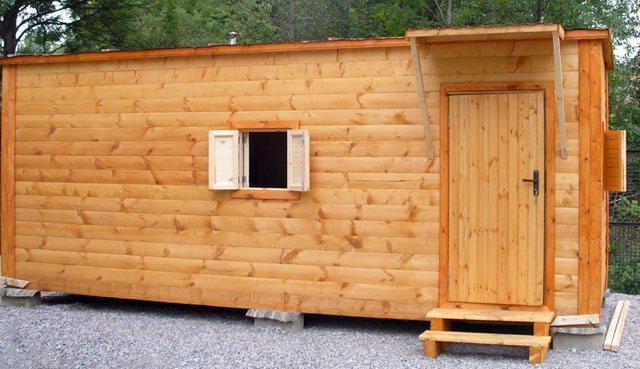
As for the treatment of the steam room, there are several points of view. According to one, treating surfaces in a steam room with any (even the most harmless) compounds is categorically unacceptable. According to another point of view, processing is possible using the most natural compounds that do not form a film on the surface of the wood.
In any case, the modern market offers a wide range of similar products from different manufacturers and price categories, which will allow you to choose the most suitable composition.
Now, knowing how to make a bathhouse from a container with your own hands, you can safely start making your dream of your own bathhouse come true!
Bath container block
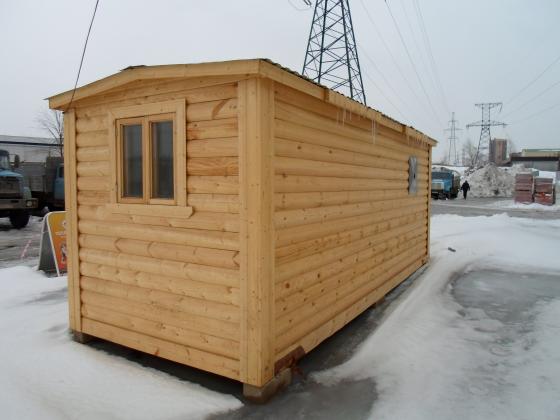
Stages of converting a container into a bathhouse
In order for things to go faster and better, it is better to divide the elaboration of tasks into certain phases.
Container installation
The module, prepared for installation, is installed on the foundation using a truck crane or raised to the required height using jacks. The position of the metal structure is checked using a building level and fixed to the piles using metal corners.
All metal surfaces are treated with anti-corrosion compounds, and door and window blocks are installed. The module has openings for ventilation, for the chimney and for the drain pipe. The space is zoned with partitions. The frame for them is made of timber, the cladding is made of boards. Doors are installed in partitions.
Foundation
The sauna can be installed on it or on a special foundationless base. The first option will become more appropriate if the bathhouse is stationary and designed for long-term use. For such a structure, it is better to build a columnar foundation at a shallow depth.
It is necessary to dig a trench 30–40 cm deep along the perimeter of the future building. This free space is filled with a cushion of gravel and sand. A columnar base is installed on top of it. This could be brickwork or concrete blocks. Then - a layer of roofing felt. And everything is covered with reinforcement on top. The bathhouse in the container is installed on the reinforcement frame itself.
Which foundation to choose for a bathhouse - container
Despite the fact that a bathhouse can stand for many years even on a simple platform with crushed stone, most owners prefer to install it on a foundation.
A lightweight five-ton container for a steam room is usually installed on columnar supports cast in concrete formwork or built of brick. If the place for the bathhouse is chosen in the forest, or on the shore of a reservoir, then it is recommended to make a crushed stone cushion under the supports. To do this, dig mini-pits according to the number of pillars to a depth of 60-70 cm, fill them with a mixture of fine sand and gravel screenings. Such a foundation will support even a forty-foot container.
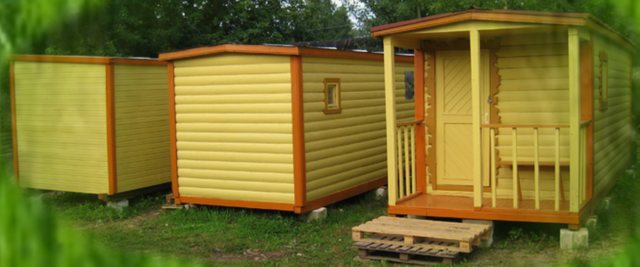
Often, the owners of a future bathhouse pour a slab foundation under the container block, motivating their decision with insurance against sagging of the building and the desire to install a second floor in the future. This is not the best option for a bathhouse. The container body is so strong that it will withstand even the collapse of 40% of the supports, and the concrete under the floor will require serious insulation of the bathhouse subfloor.
